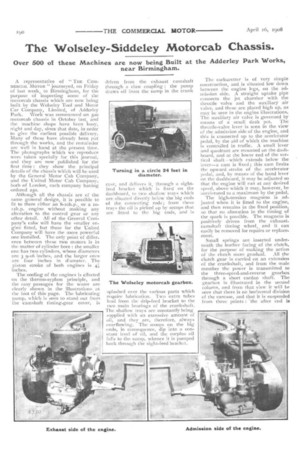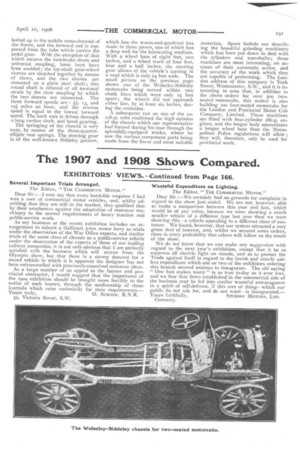The Wolseley-Siddeley Motorcab Chassis.
Page 18

Page 19

If you've noticed an error in this article please click here to report it so we can fix it.
Over 500 oY these Machines are now being Built at the Adderley Park Works, near Birmingham.
A representative of " THE COMMERCIAL MOTOR " journeyed, on Friday of last week, to Birmingham, for the purpose of inspecting sonic of the motorcab chassis which are now being built by the Wolseley Tool and Motor Car Company, Limited, of Adderley Park. Work was commenced on so° motorcab chassis in October last, and the machine shops have been busy, night and day, since that date, in order to give the earliest possible delivery. Many of these have already been put through the works, and the remainder arc well in hand at the present time. The photographs which we reproduce were taken specially for this journal, and they are now published for the first time : they show the principal details of the chassis which will be used by the General Motor Cab Company, and the United Motor Cab Company, both of London, each company having ordered 250.
Although all the chassis are of the same general design, it is possible to fit to them either an 8-toh.p., or a tot2h.p. engine without making any alteration to the control gear or any other detail. All of the General Company's cabs will have the smaller engine fitted, but those for the United Company will have the more powerful one installed. The only point of difference between these two motors is in the matter of cylinder bore : the smaller one has two cylinders, whose diameters are 3 9-16 inches, and the larger ones are four inches in diameter. The piston stroke of both engines is inches.
The cooling of the engines is effected on the thermo-syphon principle, and the easy passages for the water are clearly shown in the illustrations at the foot of this page. The lubricating pump, which is seen to stand out from the camshaft timing-gear cover, is driven from the exhaust camshaft through a claw coupling : the pump draws oil from the sump in the crank case, and delivers it, through a sightfeed bracket which is fixed on the dashboard, to two shallow trays which are situated directly below the big ends of the connecting rods ; from these trays the oil is picked up by scoops that are fitted to the big ends, and is
splashed over the various parts which require lubrication. Two extra tubes lead from the drip-feed bracket to the two main bearings of the crankshaft. The shallow trays are constantly being supplied with an excessive amount of oil, and they are, therefore, always overflowing. The scoops on the big ends, in consequence, dip into a constant level of oil, and the surplus oil falls to the sump, whence it is pumped back through the sight-feed bracket. The carburetter is of very simple construction, and is situated low down between the engine legs, on the admission side. A straight uptake pipe connects the jet chamber with the throttle valve and the auxiliary air valve, and these are placed high up, as may be seen in the engine illustrations. The auxiliary air valve is governed by means of a small dash pot. The throttle-valve lever is seen in the view of the admission side of the engine, and this is connected up to the accelerator pedal, by the aid of which the machine is controlled in traffic. A small lever and quadrant are mounted on the dashboard, and at the lower end of the vertical shaft—which extends below the lever—a cam is -fixed; this cam limits the upward stroke of the accelerator pedal, and, by means of the hand lever on the dashboard, it may be adjusted so that the engine will run at any desired speed, above which it may, however, be accelerated to a maximum by the pedal.
The high-tension magneto is adjusted when it is fitted to the engine, and then remains in the fixed position, so that no alteration in the timing of the spark is possible. The magneto is positively driven from the exhaustcamshaft timing wheel, and it can easily be removed for repairs or replacement.
Small springs are inserted underneath the leather facing of the clutch, for the purpose of making the action
of the clutch more gradual. All the clutch gear is carried on an extension of the crankshaft, and from the male member the power is transmitted to the three-speed-and-reverse gearbox through a short cardan shaft. The gearbox is illustrated in the second column, and from that view it will be seen that there is no horizontal division of the carcase, and that it is suspended from three points : the after end is
bolted up to the middle cross-channel of the frame, and the forward end is supported from the tube which carries the pedal gear. With the exception of that which secures the foot-brake drum and universal coupling, loose keys have been avoided ; the lay-shaft gear-wheel sleeves are clutched together by means of claws, and the two sleeves are mounted on a plain steel shaft ; this round shaft is relieved of all torsional strain by the claw coupling by which the two sleeves are connected. The three forward speeds arc : 51, 13, and 191 miles an hour, and the reverse speed is equal to the lowest forward speed. The back axle is driven through a long cardan shaft, and bevel gearing. The springing of the chassis is very easy, by reason of the three-quarterelliptic rear springs. The steering gear is of the well-known Siddeley pattern, which has the worm-and-quadrant box made in three, pieces, one of which has a deep well for the lubricating medium. With a wheel base of eight feet, two inches, and a wheel track of four feet, four and a half inches, the steering gear allows of the vehicle's turning in a road which is only 24 feet wide. The small picture on the previous page shows one of the Wolseley-Siddeley motorcabs being turned within two chalk lines which were only 25 feet apart ; the wheels did not approach either line, by at least six inches, during the evolution.
A subsequent run on one of the to12h.p. cabs confirmed the high opinion of the chassis which our representative had formed during his tour through the splendidly-equipped works, where he saw the various component parts being made from the finest and most suitable materials. Space forbids our describing the beautiful grinding machinery which has been put down to deal with the cylinders and camshafts ; these machines are most interesting, on account of their automatic action, and the accuracy of the work which they are capable of performing. The London address of this company is York Street, Westminster, S.W., and it is interesting to note that, in addition to the above orders for over 500 twoseated motorcabs, this maker is also building too four-seated motorcabs for the London and Provincial Motor Cab Company, Limited. These machines are fitted with four-cylinder I8h.p. engines, and the longer body necessitates a longer wheel base than the Metropolitan Police regulations will allow ; they will, therefore, only be used for provincial work.


























